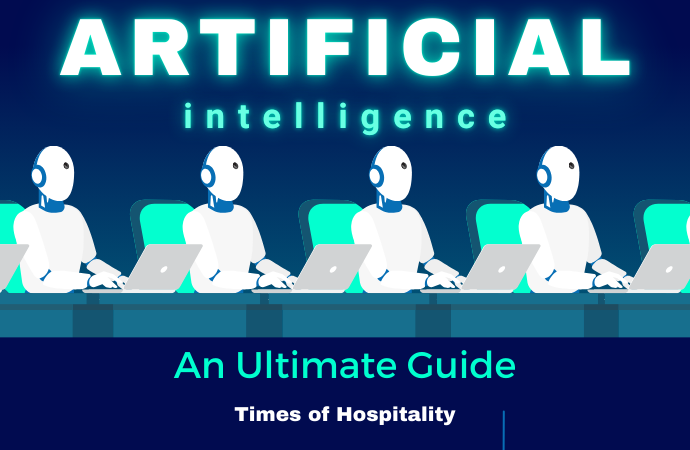Artificial intelligence (AI) is now a reality, shifting from the realm of science fiction to the realm of reality, and it is here to stay. At the same time as people all around the globe are trying to understand the implications of the technology in its present form, artificial intelligence is continuing to advance at
Artificial intelligence (AI) is now a reality, shifting from the realm of science fiction to the realm of reality, and it is here to stay. At the same time as people all around the globe are trying to understand the implications of the technology in its present form, artificial intelligence is continuing to advance at a breakneck speed. On the other hand, the far-reaching impacts of artificial intelligence have not yet been defined, whether they pertain to the area of industrial automation, scientific research, or the creative industries. Nevertheless, it is already having an effect on our day-to-day lives.
There are a lot of individuals who have trouble understanding what artificial intelligence is and what it implies for them because of the extravagant terminology that surrounds it. In this blog let’s start from the basics and understand everything about Artificial Intelligence.
Let’s Begin!
What is AI – Artificial Intelligence?
The term “artificial intelligence” (AI) refers to a technology that gives computers and other technologies the ability to replicate human intellect and the ability to solve problems.
As artificial intelligence (AI) has become more popular, businesses have been rushing to showcase the ways in which their goods and services include AI. It is common for people to refer to what they call “AI” as a well-established technology such as machine learning.
When it comes to designing and training machine learning algorithms, artificial intelligence demands specific hardware and software. Python, R, Java, C++, and Julia are all popular programming languages among those who work in artificial intelligence (AI), but there is no one programming language that is used solely in AI.
In modern times, the notion of artificial intelligence has expanded beyond the simple processing of data to include the research and development of computers that are able to learn, reason, and solve problems. Machine learning has reached a level of “competence” that allows it to produce a wide variety of content, including software code, photos, essays, videos, and music respectively. The next level of artificial intelligence is known as generative AI, and it is distinct from standard AI in terms of the skills it has and the applications it can do. The primary purpose of standard artificial intelligence systems is to analyse data and make predictions. Generative AI, on the other hand, goes one step further by producing new data that is comparable to the data it was trained on.
AI Working
The basic function of AI involves the intake of an important amount of labelled data, analysing of the data and patterns and the use of these data and patterns to create the predictions about the future state.
AI chatbots, for instance, may learn to develop realistic discussions with people by being given samples of text. Similarly, an image recognition tool can learn to identify and describe things in photographs by analyzing millions of instances. Both of these systems are examples of artificial intelligence. Realistic writing, pictures, music, and other forms of media may be produced via generative artificial intelligence systems, which have seen fast development over the last several years.
Artificial intelligence (AI) programming places an emphasis on cognitive abilities such as the following:
Acquiring knowledge. The process of obtaining data and developing rules, often known as algorithms, in order to convert it into information that can be used is a component of artificial intelligence programming. In order to do certain tasks, these algorithms provide computer devices with detailed instructions that are broken down into steps.
Being logical. Selecting the appropriate algorithm in order to get the desired result is a component of this feature.
Self-improvement and improvement. In this aspect, algorithms are always learning and tweaking themselves in order to produce the most accurate results that are feasible.
To be creative. Neural networks, rule-based systems, statistical approaches, and other artificial intelligence techniques are used in this element of the technology in order to produce new pictures, text, music, thoughts, and so on.
Advantages & Disadvantages of AI
Artificial intelligence (AI) technologies, in particular deep learning models like artificial neural networks, are able to handle massive volumes of data far more quickly and correctly than humans are able to do so. The enormous amount of data that is generated on a daily basis would be enough to bury a human researcher. However, artificial intelligence systems that use machine learning are able to take that data and swiftly transform it into knowledge that can be used.
One of the most significant drawbacks of artificial intelligence is that it is costly to analyse the vast volumes of data that it demands. AI methods are being implemented into an increasing number of goods and services; thus, businesses need to be aware of the fact that AI has the ability to generate biased and discriminating systems, whether they do so purposefully or unintentionally.
Advantages of AI
Here are some of the advantages of AI.
1. Excellent in detailed-oriented work:
In tasks that require attention to detail, excellence. Artificial intelligence is a suitable match for activities that entail recognizing subtle patterns and correlations in data that people would miss. These include tasks that involve analysing data. For instance, artificial intelligence systems have shown a high level of accuracy in the field of oncology when it comes to the detection of early-stage tumours like breast cancer and melanoma. These systems identify areas of concern that need additional investigation by medical personnel.
2. Work that requires a lot of data efficiency:
Artificial intelligence (AI) technologies and automation tools significantly cut down on the amount of time needed for data processing. very helpful in fields like as banking, insurance, and healthcare, which entail a significant amount of regular data input and analysis, as well as decision-making that is driven by data, this is a very beneficial feature. As an example, predictive artificial intelligence algorithms can evaluate enormous amounts of data in the banking and finance industry in order to anticipate market trends and assess investment risk.
3. Gains in productivity and time savings are achieved:
Not only can artificial intelligence and robotics automate processes, but they can also increase both safety and efficiency. For instance, in the manufacturing industry, artificial intelligence-powered robots are increasingly being utilized to carry out activities that are either dangerous or repetitive as part of warehouse automation. This helps to reduce the risk that human workers face while also enhancing total productivity.
4. A consistent pattern of outcomes:
The analytics tools of today make use of artificial intelligence and machine learning to handle vast volumes of data in a consistent manner, all the while maintaining the capacity to adapt to new information via the process of continuous learning. For example, AI applications have delivered consistent and reliable outcomes in legal document review and language translation.
5. Personalization and customization are available:
Personalizing interactions and the distribution of material on digital platforms is one way that artificial intelligence systems may improve the user experience. For example, artificial intelligence algorithms monitor user activity on e-commerce platforms to provide product recommendations that are tailored to an individual’s tastes. This results in increased consumer happiness and engagement.
6. Round-the-clock accessibility is provided:
The requirement for AI algorithms to sleep or take breaks is not necessary. For instance, virtual assistants that are driven by artificial intelligence are able to offer continuous customer support around the clock, even when there is a large number of interactions. This helps to improve response times and save expenses.
7. Capacity to grow:
The capacity of AI systems to manage increasing quantities of labour and data may be scaled. Because of this, artificial intelligence is well suited for situations in which the amount of data and the amount of effort may increase rapidly, such as internet search and corporate analytics.
8. Enhancement of the research and development process:
Artificial intelligence has the potential to accelerate research and development in a variety of sectors, including materials science and medicines. Artificial intelligence models may assist researchers in the discovery of novel medications, materials, or molecules more quickly than conventional approaches can. This is accomplished by rapidly simulating and evaluating a large number of different situations.
Disadvantages of AI
Here are some of the disadvantages of AI.
1. High Cost
Developing artificial intelligence may be an extremely costly endeavour. In order to construct an artificial intelligence model, it is necessary to make a significant initial investment in infrastructure, computer resources, and software specifically designed to train the model and store its training data. Furthermore, there are continuous costs associated with model inference and retraining that are incurred after the initial training has been completed. As a consequence of this, expenses may rapidly accumulate, especially for sophisticated and intricate systems such as apps that use generative artificial intelligence; OpenAI CEO Sam Altman has said that the training of the company’s GPT-4 model cost more than one hundred million dollars.
2. Intricacy of the methodology
A significant amount of technical expertise is required in order to develop, operate, and debug artificial intelligence (AI) systems, particularly in production settings that are based on the real world. In many instances, this knowledge is distinct from that which is required to construct software that is not based on artificial intelligence. A sophisticated, multi-stage, and highly technical process is required, for instance, in order to construct and launch a machine learning application. This process includes everything from the preparation of data to the selection of algorithms to the tuning of parameters and the testing of models.
3. The talent gap exists
The fact that there is a considerable lack of experts educated in artificial intelligence and machine learning in comparison to the rising demand for such talents is a challenge that is compounded by the complexity of the technical aspects. Despite the fact that there is a rising interest in applications of artificial intelligence, many businesses are unable to locate sufficient competent personnel to staff their AI efforts because of the gap between the supply of AI talent and the demand for it.
4. A bias in the algorithm
The biases that are present in the training data of artificial intelligence and machine learning algorithms are reflected in the algorithms themselves, and when AI systems are implemented at scale, the biases also scale. There are situations in which artificial intelligence systems may potentially increase slight biases in their training data by encoding them into patterns that are both reinforceable and pseudo-objective. In a well-known example, Amazon constructed an artificial intelligence-driven recruiting tool with the intention of automating the hiring process. However, the program mistakenly preferred male applicants, which is reflective of larger-scale gender disparities in the technology sector.
5. The inability to generalize is shown
When it comes to addressing unique circumstances, artificial intelligence models often do very well when it comes to the particular duties for which they were taught. since of this lack of adaptability, artificial intelligence may not be as valuable as it may be since new tasks may need the creation of a completely new model. Without considerable extra training, a natural language processing (NLP) model that was trained on text in the English language, for instance, would not function well when applied to text in other languages. In spite of the fact that efforts are now being made to enhance the generalization capability of models, sometimes referred to as domain adaptation or transfer learning, this is still an unresolved research issue.
6. Jobs that have been eliminated
A rising area of worry as the capabilities of AI models get more advanced and corporations increasingly try to automate processes using AI is the possibility that humans could lose their jobs as a result of artificial intelligence (AI) if organizations replace human workers with machines. Some copywriters, for instance, have complained that they have been supplanted by large language models (LLMs) like ChatGPT. Despite the fact that broad adoption of AI may potentially result in the creation of new job categories, it is possible that these new job categories may not coincide with the occupations that are lost, which raises issues about economic inequality and reskilling.
7. Security vulnerabilities
It is possible for artificial intelligence systems to be vulnerable to a broad variety of cyberthreats, such as data poisoning and adversarial machine learning. By way of example, hackers are able to obtain sensitive training data from an artificial intelligence model or fool AI systems into generating output that is erroneous and potentially destructive. This is especially problematic in areas that are extremely sensitive to security, such as the government and the financial services industry.
8. Environmental effect
Large quantities of energy and water are used by the network infrastructures and data centers that are the foundation for the operations of artificial intelligence models. The training and operation of artificial intelligence models therefore has a substantial influence on the environment. When it comes to big generative models, artificial intelligence’s carbon footprint is particularly important since these models demand a significant number of computational resources for training and continuing usage.
Types of AI
The following is a list of the categories
1. Reactive machines are the first kind
The AI systems in question are task-specific and do not possess any memory. Deep Blue, the IBM chess software that defeated the Russian chess champion Garry Kasparov in the 1990s, is a good illustration of this. Deep Blue was able to recognize pieces on a chessboard and make predictions, but since it lacked memory, it was unable to draw conclusions from its previous experiences nor could it utilize those experiences to guide its future actions.
2. Memory is restricted in type 2
Because these artificial intelligence systems have memories, they are able to draw on their previous experiences to guide their decision-making in the future. This approach is used in the design of some decision-making systems that are included in autonomous vehicles.
3. Theory of mind is the third kind
Theory of mind is a word that is used in psychology. This term, as used to artificial intelligence, refers to a system that is able to comprehend feelings. One of the most important capabilities for artificial intelligence systems to possess in order for them to become essential members of traditionally human teams is the ability to discern human intentions and forecast behaviour.
4. Self-awareness is the last kind
AI systems that fall under this category possess a sense of self, which enables them to experience consciousness. Those machines that possess self-awareness are aware of their own present condition. This particular kind of artificial intelligence does not yet exist.
Read This Also: Rainy Days Bring Delhi Its Cleanest Air in Nearly 297 Days




















Leave a Comment
Your email address will not be published. Required fields are marked with *